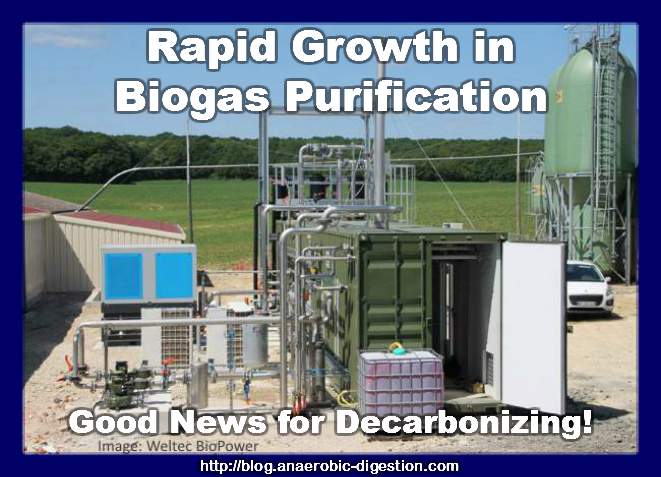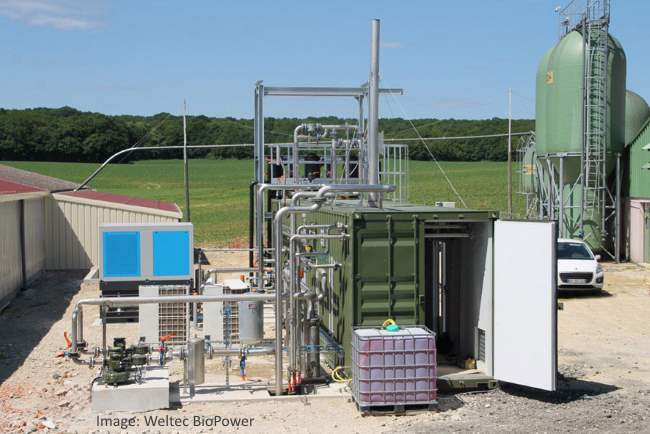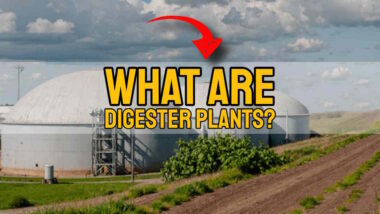As the global demand for sustainable and renewable energy sources continues to surge, biomethane plants have emerged as pivotal players in the transition towards a greener future. By focusing on the purification and upgrading of biogas, these plants convert organic waste into pure natural methane, suitable for transport fuel or injection into gas grids.
This transformation not only mitigates environmental impact but also promotes energy security and economic growth. In this comprehensive overview, we delve into the advantages of biomethane plants, exploring their role in biogas upgrading purification and the broader benefits they bring to society and the environment.
Understanding Biomethane Plant Production
Biomethane, often referred to as renewable natural gas (RNG), is produced through the anaerobic digestion of organic materials such as agricultural waste, municipal solid waste, and industrial by-products. The process involves breaking down these materials in the absence of oxygen, resulting in the production of biogas—a mixture primarily composed of methane (CH₄) and carbon dioxide (CO₂).
A purification process is required to remove impurities from the “raw” biogas. leaving almost pure methane. It is this pure methane that it called “biomethane”.

The Upgrading Process
To convert raw biogas into biomethane, several purification steps are employed:
- Removal of Impurities: This involves eliminating contaminants such as hydrogen sulfide (H₂S), siloxanes, and particulates that can damage equipment and reduce gas quality.
- Carbon Dioxide Separation: Techniques like pressure swing adsorption (PSA), membrane separation, and water scrubbing are used to remove CO₂, increasing the methane concentration.
- Drying: Ensuring the biomethane is free from moisture to prevent pipeline corrosion and meet quality standards.
These steps transform biogas into high-purity methane, making it suitable for injection into natural gas grids or use as a clean transport fuel.
Key Advantages of Biomethane Plants
1. Environmental Benefits
Biomethane plants offer substantial environmental advantages, contributing to the reduction of greenhouse gas emissions and the promotion of sustainable waste management practices.
- Methane Capture: By capturing methane from organic waste, these plants prevent its release into the atmosphere, where it is a potent greenhouse gas with a global warming potential significantly higher than carbon dioxide.
- Waste Diversion: Organic waste diverted from landfills and other disposal methods reduces environmental pollution and landfill-related issues such as leachate production and soil contamination.
- Renewable Energy Production: Biomethane serves as a clean energy source, replacing fossil fuels and thereby decreasing carbon emissions associated with energy consumption.
Insert infographic illustrating greenhouse gas emission reductions through biomethane production.
2. Energy Security and Reliability
Biomethane contributes to a diversified and resilient energy supply, enhancing energy security and stability.
- Local Energy Production: Biomethane plants often utilize locally sourced organic materials, reducing dependency on imported fossil fuels and enhancing energy independence.
- Consistent Supply: Unlike some renewable sources like wind and solar, biomethane production can provide a stable and continuous energy supply, unaffected by weather conditions.
3. Economic Advantages
Investing in biomethane plants yields significant economic benefits for communities and industries alike.
- Job Creation: The construction, operation, and maintenance of biomethane facilities create numerous employment opportunities across various skill levels.
- Revenue Generation: Farmers and waste generators can monetize their organic waste streams by supplying them to biomethane plants, providing an additional income source.
- Cost Savings: Utilizing biomethane as a fuel can lead to cost savings for transportation and industrial operations, especially when compared to conventional fossil fuels.
Include a table comparing the costs of biomethane versus traditional natural gas over time.
4. Technological Advancements
The biomethane sector is at the forefront of several technological innovations aimed at enhancing efficiency and reducing costs.
- Advanced Upgrading Technologies: Innovations in biogas purification processes have increased methane yields while lowering energy consumption and operational expenses.
- Smart Monitoring Systems: Integration of digital technologies for real-time monitoring and optimization of biogas production ensures higher efficiency and reliability.
- Modular Plant Designs: Flexible and scalable plant designs allow for easier expansion and adaptation to varying scales of operation, making biomethane accessible to a broader range of applications.

5. Regulatory and Policy Support
Government incentives and supportive policies are driving the growth of biomethane production, creating a favorable environment for investment and expansion.
- Subsidies and Grants: Many regions offer financial incentives for renewable energy projects, including biomethane plants, reducing initial capital barriers.
- Carbon Credits: Biomethane production can generate carbon credits, providing additional revenue streams and encouraging environmentally responsible practices.
- Renewable Energy Mandates: Policies mandating the incorporation of renewable energy sources in national grids boost the demand and viability of biomethane.
Applications of Biomethane
The versatility of biomethane extends its utility across various sectors, enhancing its value proposition.
1. Transport Fuel
Biomethane is an excellent alternative to diesel and gasoline, offering a cleaner and more sustainable option for transportation.
- Compressed Natural Gas (CNG) and Liquefied Natural Gas (LNG): Biomethane can be compressed or liquefied for use in vehicles, reducing emissions and promoting cleaner air in urban areas.
- Fleet Operations: Public transportation systems and logistics companies can significantly lower their carbon footprint by switching to biomethane-powered vehicles.
2. Gas Grid Injection
Injecting biomethane into existing natural gas grids increases the proportion of renewable energy in the overall gas supply.
- Seamless Integration: Biomethane is chemically identical to natural gas, allowing for seamless blending and distribution through existing infrastructure without the need for significant modifications.
- Energy Storage: Gas grids can act as large-scale energy storage systems, balancing supply and demand fluctuations and enhancing grid stability.
3. Industrial Applications
Industries requiring high-purity methane can benefit from biomethane as a reliable and sustainable energy source.
- Manufacturing Processes: Biomethane can power various manufacturing operations, reducing reliance on fossil fuels and lowering production costs.
- Heating and Cooling: Industrial facilities can use biomethane for heating and cooling processes, improving energy efficiency and reducing emissions.
Challenges and Solutions in Biogas Upgrading Purification
While biomethane plants offer numerous advantages, they also face certain challenges that need to be addressed to maximize their potential.
1. High Initial Investment
Challenge: The upfront capital required for setting up biomethane plants can be substantial, potentially deterring investors.
Solution: Leveraging government subsidies, grants, and attractive financing options can mitigate initial costs. Additionally, showcasing long-term economic benefits and return on investment can encourage stakeholder participation.
2. Technological Complexity
Challenge: The biogas upgrading process involves complex technologies that require specialized knowledge and expertise.
Solution: Investing in workforce training and partnering with technology providers can ensure smooth operations. Continuous research and development can also lead to more user-friendly and efficient upgrading solutions.
3. Feedstock Variability
Challenge: The quality and quantity of organic feedstock can vary, affecting biogas production consistency.
Solution: Implementing robust feedstock management systems and diversifying feedstock sources can enhance reliability. Advanced monitoring and control systems can adjust processes in real-time to accommodate variations.
The Future of Biomethane Plants
The trajectory for biomethane plants is promising, driven by technological advancements, supportive policies, and increasing environmental awareness. As innovation continues to lower costs and improve efficiency, biomethane is set to play a pivotal role in the global energy landscape.
Key Trends to Watch:
- Integration with Circular Economy: Biomethane production will become increasingly integrated with circular economy practices, utilizing waste streams more effectively and promoting resource efficiency.
- Decentralized Production Models: Smaller, decentralized biomethane plants will emerge, catering to local energy needs and reducing transmission losses.
- Hybrid Energy Systems: Combining biomethane with other renewable energy sources, such as solar and wind, will create hybrid systems that enhance overall energy resilience and sustainability.
Why are Most New Biogas Plants Now Being Built to Make Biomethane?
The reason for this is that forward-looking biogas plant developers have seen a wonderful opportunity. They are supplying HGV vehicle fleets with biomethane.
Growth in this use of biomethane is thought of as being potentially so large that it is an almost insatiable market.
No matter how many biomethane digesters are built they don't see the biogas industry being able to meet the coming demand.
Current EU and UK gas grid utility company contract competition rules allow biomethane injected into the gas pipelines anywhere in the country to be bought directly from the biomethane producer. Obviously, the gas itself which is supplied isn't physically the same gas that was injected, but that does not matter.
Biomethane is stored and utilised on a gas grid during periods when there is no wind or sun. Its use removes the need to use batteries which are:
- expensive
- require the use of rare elements of limited global availability
- deteriorate from the day you buy them
- are hard to dispose of responsibly.
Similarly, it may be utilised as a CO2-neutral high-temperature heating media, filling gaps where current electrical solutions (heating pumps and heaters) are unable to supply enough energy to meet large-scale industrial demands.
Biomethane can be compressed or liquefied (as CBG or LBG) and that enables it to be delivered to pumps at existing petrol (gas) filling stations and utilised as a fuel, for example, in the transportation industry (trucks, trains, heavy machinery, ships). The energy loss in doing this is low, perhaps 10% of 15% of the energy used in the vehicle.
This makes a great deal more sense than using the biogas to run electrical generators. All electricity grids are inefficient and frequently experts quote a little as one-third of the energy delivered into the electricity grid as reaching the appliance in which it is used.
Stable and Rising Prices for Biomethane Producers
The market price for biomethane, (which is interchangeable in quality with fossil fuel derived “natural gas”), is substantially higher than for biogas. It also:
- is rising as more companies convert to biomethane to power their trucks so supply-and-demand is tending to push the price upward
- fluctuates less than the value of the unrefined biogas in the markets
- and as nations introduce “Green Gas” schemes to reduce carbon emissions and comply with Net Zero 2050 agreements, large fuel users are being required to pay a duty if they don't use a set quota of renewable gas.
The rapid growth in biogas purification is a development that will incidentally help nations to de-carbonize their energy use. This biogas use started around the year 2014 in the UK when the attraction of pure methane production arose from its merits as a transport fuel.
At this blog, we have often said that anaerobic digestion has great potential. But by “upgrading” and producing methane-based biofuel (biomethane) takes the technology up to a whole new level.
Why “Upgrading” was Rare Until 2013 in the UK
Until 2013 producing biogas to power an electric generator was for injection of electricity into the public electricity grid was as far as AD Plant developers went.
To gain funding assistance from the big financial institutions was before 2013 was difficult in Europe, and almost impossible in many countries. The reason was that the “natural gas” grid supply companies were unable to accept injected biomethane. This was often for technical and legal reasons.
But this is changing as national regulations about public natural gas supplies are updated to more “green” policies.
Investor Doubts About AD's Long Term Profitability Fall Away
Until around about 2013 to get backing for any AD facility beyond a basic commercial AD Plant coupled to a gas engine to generate electricity was very hard. It was almost impossible to negotiate for funding with biogas facility institutional and commercial funders.
That is changing rapidly globally. Until recently, the higher cost of biomethane above natural gas often meant that the natural gas supply company was reluctant to take biogas (biomethane) powered electricity. Not any more!
Thankfully, climate change concerns now mean that gas grid supply utility companies are keen to take any biomethane that they can get.
Environmental Benefits of Upgrading a Biogas Plant to Produce Biomethane
A biomethane separation “upgrading” facility produces biomethane from the raw biogas from an anaerobic digestion plant.
This takes the digester's biogas and splits it into biomethane and carbon dioxide (CO2). CO2 is released into the atmosphere. However, this CO2 is organic CO2 and has not been produced by unlocking stored CO2 where for millennia it has been locked up safely below ground in geological deposits. This CO2 should not be seen as anywhere near as damaging as fossil fuel CO2.
Also, this pure CO2 can easily be compressed and is readily either sold as a product where it has real value to the industry, or it can easily be “sequestrated”. This is done by a simple chemical reaction to lock it away and prevent it from entering the atmosphere again.
For example, when bound chemically in solid form as carbonate rock and buried, the carbon dioxide is effectively removed permanently from the atmosphere. In fact, if this is done it makes the biomethane process facility actively “carbon emission negative”.
Biomethane Production Not Limited Only to On-Grid Locations Accessible to 11kV Lines
In the past biogas could only be produced and the electricity exported in locations where the AD Plant was close enough to the 11 kV power lines to be able to connect to them at a reasonable cost.
Even if a farm is close to an 11 kV supply the line can often be too low-capacity to accept the power from a biogas generator.
Many potential biogas plants were as a result not viable.
What is Needed for Biogas Upgrading?
To produce high-value biomethane or BioCNG, as well as clean truck gas, and car, fuel. You need a biogas upgrading system. These come by the names of biogas purifiers, biogas purification plants, and biogas upgrading equipment. But, first, you need biogas.
The biogas is generated as raw biogas mixed with CO2 and traces of other impurities from a variety of wastes, including:
- animal manure and general crop wastes
- municipal solid waste (organic fraction)
- sugar crane press mud
- root vegetable tops from food preparation, and
- food waste.
Many different forms of biodegradable garbage and organic farm waste are available for biogas production.
Companies Offering Upgrading Equipment
1. DMT
DMT Clear Gas Solutions claims to be the world's fastest-growing biogas technology firm.

On DMT's website, it explains that they have invested over 30 years in biogas upgrading and desulphurization equipment development. Their Carborex MS technology is one of the primary product lines offered by DMT Environmental Technology. This device transforms biogas into pure methane.
The biomethane produced by their system may either be sent into the national gas system or compressed into natural gas (which they brand as “Carborex CNG”) for use as vehicle fuel. DMT also goes one stage further and offers technology for converting biogas all the way to LNG.
The product is sold in cylinders, and once again is a green option when compared with normal LNG.
There is a strong and growing market for this Renewable LNG.
2. Bright Biomethane
Bright biomethane provides what they describe as “well-proven systems” that convert biogas to biomethane in standard capacities ranging from 40 nm3/hr to 5,000 nm3/hr (and higher). As a result, Bright Biomethane describes itself as one of the few providers capable of delivering the entire spectrum of biogas upgrading facilities, from modest to very big.
Purepacs from Bright Biomethane are biogas upgrading systems that can be readily installed into any biogas production. They describe their biogas upgrading systems are suited for upgrading biogas produced from all types of biomass including waste from existing and new biogas plants.
Their technology allows you to create renewable and CO2-neutral biomethane for injection into the natural gas system or use as a car, van, truck (and anything in-between!) fuel. The system has been around for a while and undoubtedly their biogas upgrading system is tried and true, as well as simple, large and small.
“When you use this technology to convert biogas to climate-friendly biomethane, you obtain clean energy that benefits both your economy and the environment”,
is a statement made about this product.
Greenmac is a Dutch biogas upgrading technology company with expertise in membrane and amine technology has been purchased by Bright Biomethane from the Rootselaar group.
3. Airco Process Technology
Airco's biogas plant upgrading solution is a comprehensive electrical solution that collects and uses about 99.9% of the biomethane.
Liquefied biomethane (LBM) production from biogas, as accomplished by the Airco technology, involves two primary energy-intensive processes:
- upgrading to enhance methane concentration and
- refrigeration to liquefy the improved biogas.
Amine-based absorption is used. It's a technology that has long been regarded as an appealing alternative for biogas upgrading in industrial applications.
The temperature rise caused by amine regeneration, on the other hand, is incompatible with the cooling need of the following liquefaction process. As a result, Airco is developing the use of cryogenic biogas upgrading combined with liquefaction has emerged as an intriguing option.
4. SGR Biomethane SRL
SGR Biomethane S.R.L. was founded in 2012 by a pioneering Italian start-up in the field of renewable fuel and smart grid technology. The company focuses on projects of upgrading biogas to biomethane. It was reportedly one of the first firms in Italy to use membrane technology to upgrade raw biogas into biomethane.
5. Host Biogas Biomethane Plant Equipment
Host biogas, a Dutch bioenergy business, provides and services biogas upgrading installations for the European market. They provide systems for converting biogas to biomethane using high-efficiency membrane technology and provide 24-hour service support to their users.
Pressure Swing Adsorption (PSA) Technolgy Companies
PSA (Pressure Swing Adsorption) biogas upgrading and purification systems are also available from long-established companies in PSA equipment provision for the chemical industries.
It is worth noting that these suppliers can offer their products for the production of biomethane from biogas.
The PSA technique uses a carbon molecular sieve to separate gases at ambient temperatures. These may use CMS, a material that adsorbs carbon dioxide to leave a rich stream of biomethane.
Features of Modern Biomethane Purification Technology
These systems are entirely automated. Complex controls guarantee that the equipment responds quickly to variations in the biogas supply.
The effectiveness of the operation may be improved further with remote monitoring and tailored service and maintenance contracts.
The conversion of biogas to biomethane offered is more and more often based on energy-saving membrane technology. The use of these membranes enables the achievement of natural gas standards needed by gas utility operators.
Methane (biomethane) is either:
- injected into a medium-pressure gas line.
- Or, another approach is to separate the CO2 from the methane in biogas and utilise the methane as a motor fuel (CNG).
In addition to biomethane production, the technique enables the generation of carbon dioxide (CO2) for use in the food and beverage industries, as well as greenhouses.
The conversion to biomethane is allowing biogas uses to be expanded into transportation sectors, therefore helping EU carbon neutrality targets.
Currently, the decision seems to be comprehensively in the affirmative for upgrading. With the increasing demand for “green renewable natural” gas these days. Plus, there is much clamour for clean air in cities demanding clean fuel for transport fleets. Therefore, the market for the “biomethane” produced must be almost insatiable. Biomethane is a product that truly sells itself!
That also looks like continuing in the long term. So, we recommend considering “upgrading” all new and existing biogas plants.
We also confidently predict that as uptake of the gas separation technologies used increases many technical improvements will be made. And upgrading equipment costs will continue to fall.
Getting Started with Biomethane
Embracing biomethane production offers a pathway to sustainable energy and environmental stewardship. Whether you're a farmer, a waste management entity, or an industrial player, integrating biomethane into your operations can yield significant benefits.
Contact Us Today
Ready to explore the advantages of biomethane for your business or community? Our team of experts is here to guide you through every step of the process—from initial assessments to project implementation and ongoing support.
To get a Free Consultation Contact Us via our email form here.
Frequently Asked Questions
1. What is the difference between biogas and biomethane?
Biogas is a mixture primarily composed of methane and carbon dioxide, produced through the anaerobic digestion of organic materials. Biomethane is biogas that has been purified to remove CO₂ and other impurities, resulting in high-purity methane suitable for use as a fuel or for injection into gas grids.
2. How long does it take to set up a biomethane plant?
The timeline for setting up a biomethane plant varies based on plant size, technology selection, and regulatory approvals. On average, it can take between 12 to 24 months from planning to operational status.
3. Is biomethane a cost-effective alternative to natural gas?
While the initial investment for biomethane production can be high, long-term operational savings, government incentives, and the added value of waste management can make biomethane a competitive and cost-effective alternative to traditional natural gas.
Join the Renewable Energy Revolution
Biomethane plants are at the forefront of sustainable energy solutions, offering a blend of environmental, economic, and social benefits. By advancing biogas upgrading purification, we can unlock the full potential of organic waste, transforming it into a valuable resource that powers our communities and preserves our planet for future generations.
Stay Connected
Stay informed about the latest developments in biomethane technology and renewable energy by subscribing to our newsletter.
Excerpts from the Original Article (Written in 2015)
The following are just some of the examples of biomethane projects from our original article on this subject:
Construction underway on British Columbia biomethane project
“The Surrey biofuels processing facility is being constructed with two main components. These will be the primary biofuel process area, which covers most of the building footprint. And the administrative area, which is at the building entry. City of Surrey, British …and more »”
To find out more about “Construction underway on British Columbia biomethane project – Biomass Magazine” and anaerobic digestion,
Estonia´s public transport turns to bio-methane – PetrolPlaza
“PetrolPlaza Estonia´s public transport turns to bio-methane. PetrolPlaza”Fuel, produced from local raw materials is essential to ensure Estonia's energy independence. And the use of biomethane in public transport will bring cleaner air to cities. Public transport will be transferred to more environment-friendly fuel,” said Michal.
We sincerely feel that anaerobic digestion, and related technologies such as Gas Plasma, can change the world”
UK Government Funds Pioneering Waste to Biomethane Plant – NGV Global
“BBC News – UK Government Funds Pioneering Waste to Biomethane Plant. NGV Global (press release) (blog). APP says the new plant in Swindon will be the first of its kind in the world, taking residual waste. Residual waste is the UK's largest sustainable source of biomass. Converting it into compressed biomethane, using APP's pioneering Gasplasma® technology would be a major gain. An £11m grant has been awarded to help build green energy plant.”
And, also:
France prepares for biomethane take-off
“InterfaxGlobal Energy” France is preparing for the launch of biomethane. A slew of new biogas facilities is poised to bolster the French gas grid. It will do this via direct injection, and the fuel is receiving substantial government assistance.”
Written by. Astrid Madsen. Posted 28 September 2015.”
And, also:
ELTEC Biomethane Plant in France Launches Feed-in
GrDF (Gaz re Seau Distribution France):
On August 5, 2015, the Longchamps biomethane plant in the Franche-Comte region of eastern France went online. Thus, 70 standard m3/h of natural gas are now constantly provided. This amount is fed daily into the natural gas system of the French gas distributor.
The plant's operator, David Peterschmitt, uses around 6,000 t of agricultural waste each year to create biogas via anaerobic digestion.
To ensure effective biogas processing, WELTEC BIOPOWER, a German plant manufacturer, uses flexible, small membrane technology. Methane is separated from carbon dioxide (CO2), water vapour, and other components in three steps using specialised polymer membranes.
With a methane production of about 99%, the WELTEC membrane technology is extremely efficient.
Upstream compression is another advantage of the approach. As a consequence, the separated methane already has the appropriate pressure to be fed into the natural gas system. Therefore, it does not need further compression.
This saves money by eliminating the need for an additional compressor. Plus, it also enables WELTEC biogas processing to be utilised cheaply in smaller plants.
Methane Processing Method Savings
This processing method also saves money in other ways, such as:
- At room temperature and
- without the application of chemicals, the molecules are separated.
Furthermore, the membrane technology distinguishes itself by its compact set-up in the container, which saves installation costs.
WELTEC used the custom-built LoMOS SPS control to improve plant synchronisation. SQL database-based task management is one of the system's distinguishing features:
The user just enters his specific tasks for the biogas plant into the user-friendly calendar. The LoMOS control automatically conducts the inputs.
The builder and operator, David Peterschmitt, is optimistic about the user-friendly operation and high-quality components:
“I am certain that the technology used by WELTEC BIOPOWER will provide optimum efficiency. In addition, it will also provide long-term, stable, and cost-effective operation of my biomethane plant.”
All this amounts to a biomethane “explosion”! A huge growth biomethane plant capacity is occurring. Pure green methane fuel production using the greenest possible technology of Anaerobic digestion is the way ahead.
[Article updated on 21 August 2021, and again on 9 March 2025.]






This is the next stage of biogas adoption. Purified biogas is just the same as “natural gas”, so the market for biomethane is as huge as for natural gas, but even larger because biomethane is properly “green” (renewable) and natural gas only “green” when compared with coal use.
I am looking for a financial template. I wish to use one such to calculate my payback for biogas upgrading my AD system. Where can this be found?
This might be the solution to the high prices of lpg